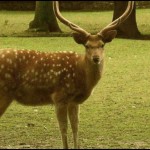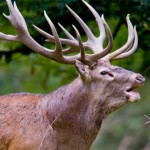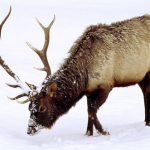Family Cervidae: The Deer
Deer, Moose, Elk, and Caribou
The cervids include deer and their allies, including familiar moose, elk, and caribou. Member of this family occupy a wide range of habitats, from arctic tundras to tropical forests, and native species of cervids can be found over most of the world except Africa south of the Sahara, Australia, and Antarctica. They have also been introduced to a number of areas that originally had no cervids. Currently, we recognize around 44 species of living cervids, placed in 17 genera, including a new genus and species (Megamuntiacus vuquangensis) recently discovered in the Annamite Mountains of southeastern Asia. Deer are sometimes divided into four subfamilies. Some taxonomists include the genus Moschus (musk deer) within the Cervidae, but here we follow recent authorities and place it in its own family, the Moschidae.
References to other good Cervid information
- Feldhamer, G. A., L. C. Drickamer, S. H. Vessey, and J. F. Merritt. 1999. Mammalogy. Adaptation, Diversity, and Ecology. WCB McGraw-Hill, Boston. xii+563pp.
- Nowak, R.M. and J.L. Paradiso. 1983. Walker’s Mammals of the World, 4th edition . John Hopkins University Press, Baltimore, MD.
- Savage, R. J. G. and M. R. Long. 1986. Mammal Evolution: An Illustrated Guide. Facts on File Publications, UK. 251 pp.
- Simpson, C. D. 1984. Artiodactyls. Pp. 563-587 in Anderson, S. and J. K. Jones, Jr. (eds). Orders and Families of Recent Mammals of the World. John Wiley and Sons, N.Y. xii+686 pp.
- Vaughan, T. A. 1986. Mammalogy. Third Edition. Saunders College Publishing, N.Y. vii+576 pp.
- Vaughan, T. A., J. M. Ryan, N. J. Czaplewski. 2000. Mammalogy. Fourth Edition. Saunders College Publishing, Philadelphia. vii+565pp.
- Wilson, D. E., and D. M. Reeder. 1993. Mammal Species of the World, A Taxonomic and Geographic Reference. 2nd edition. Smithsonian Institution Press, Washington. xviii+1206 pp.&160;



































































































